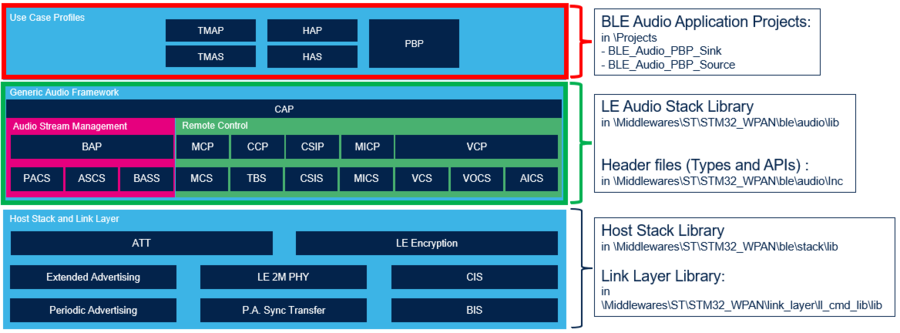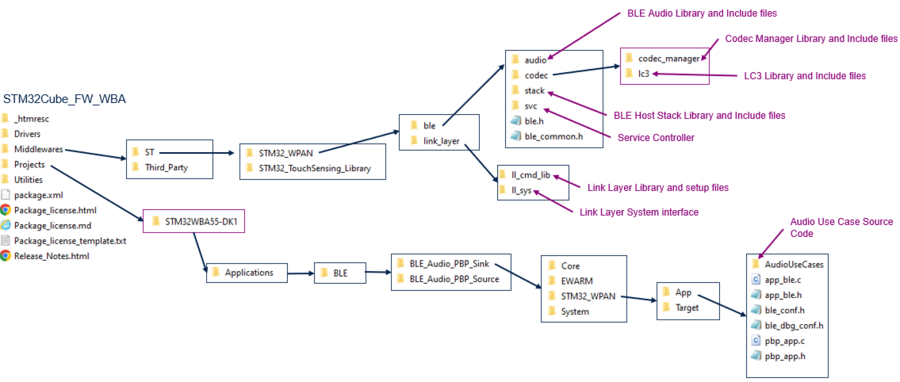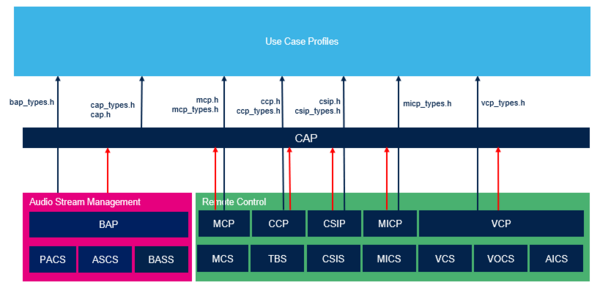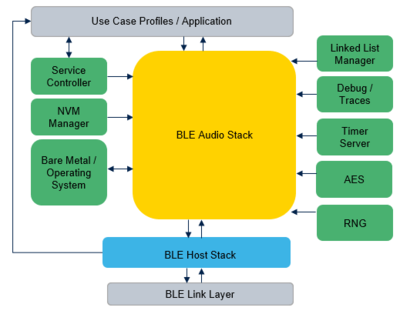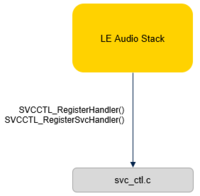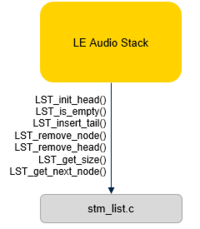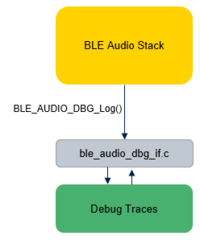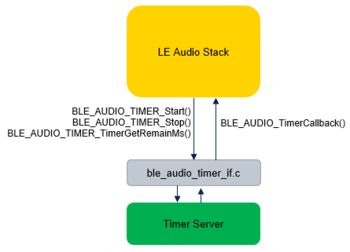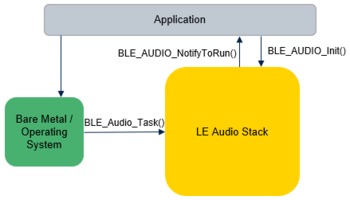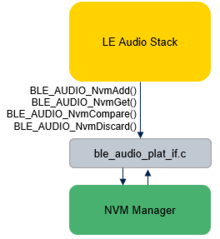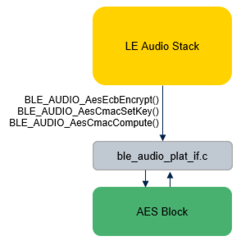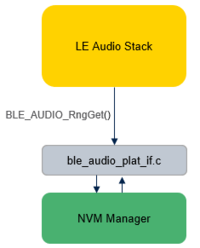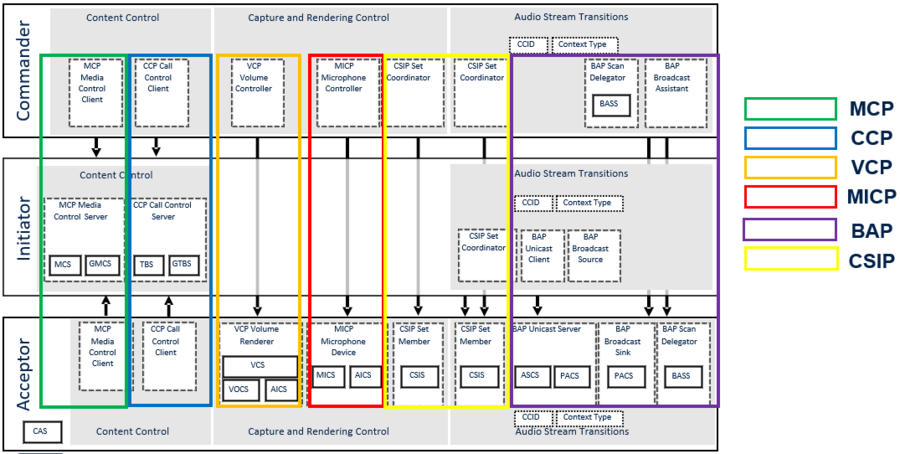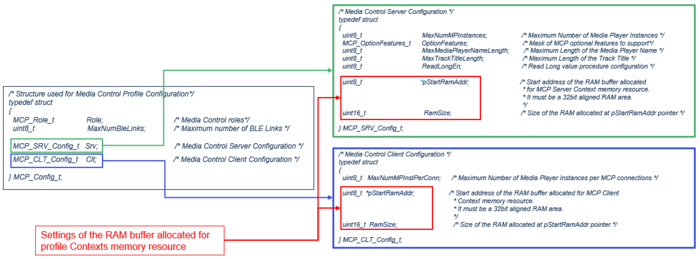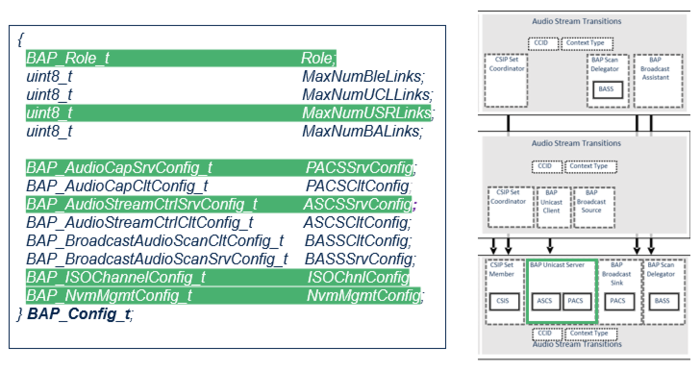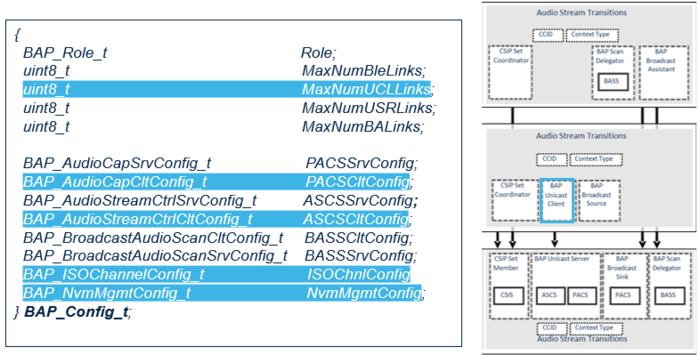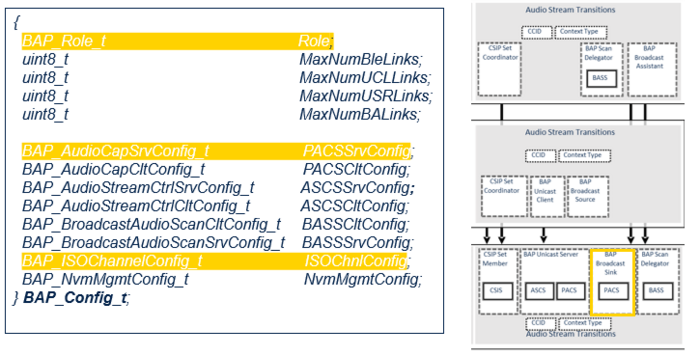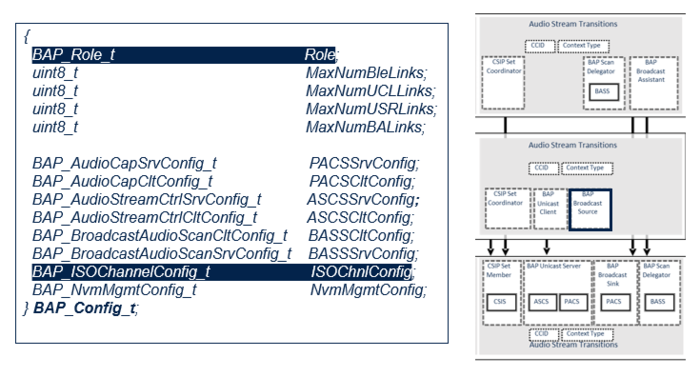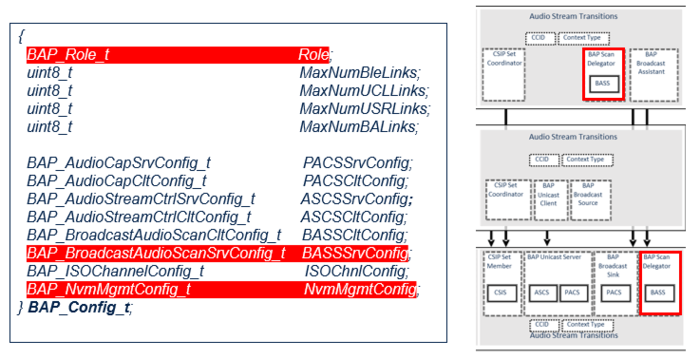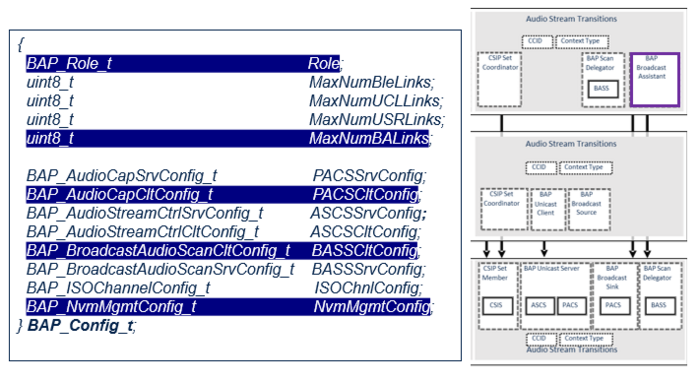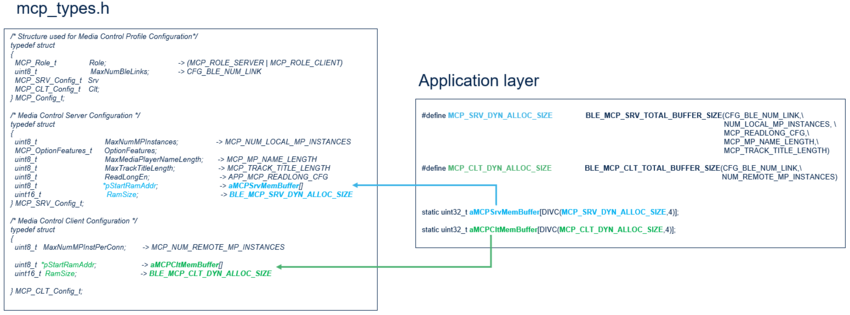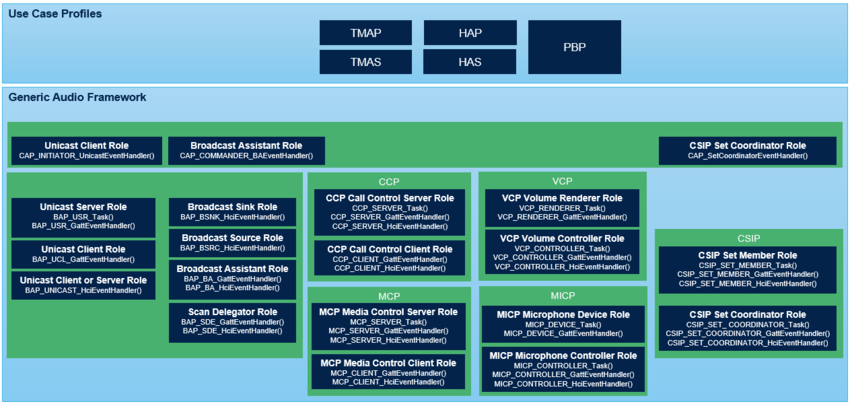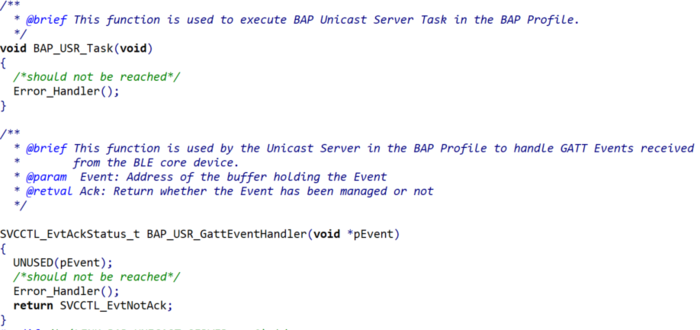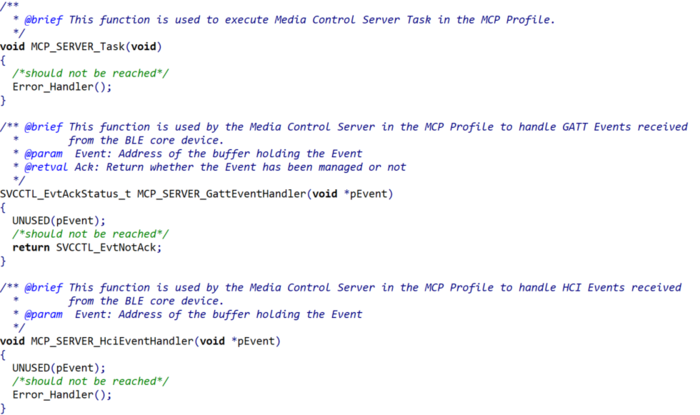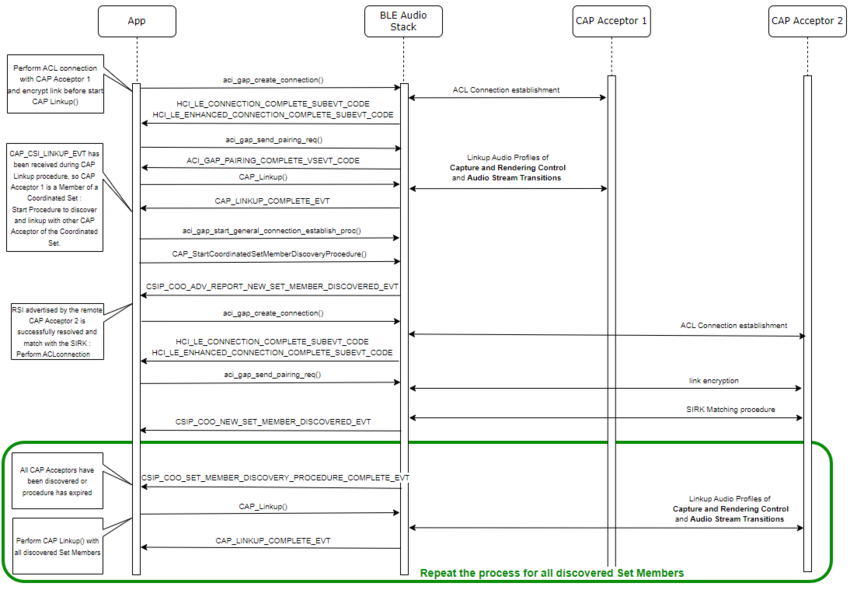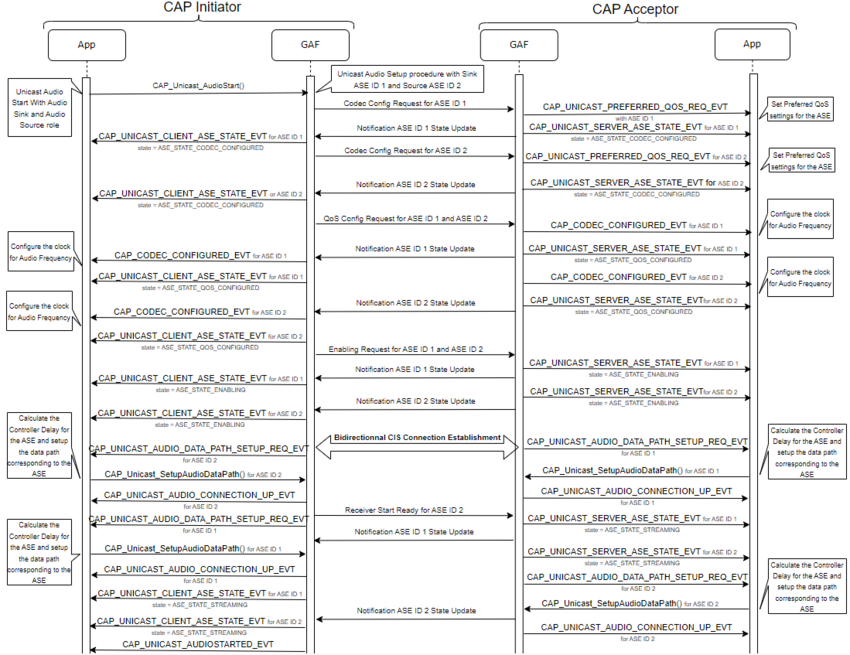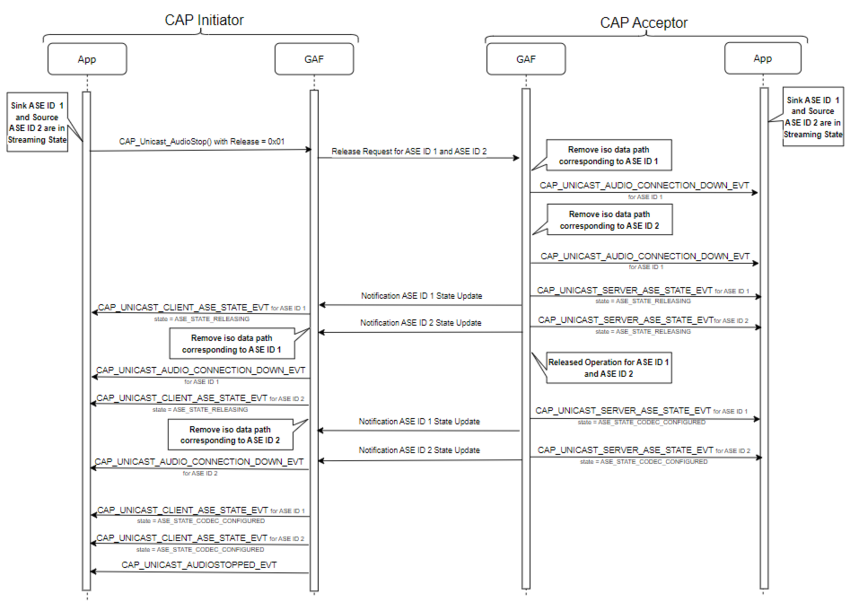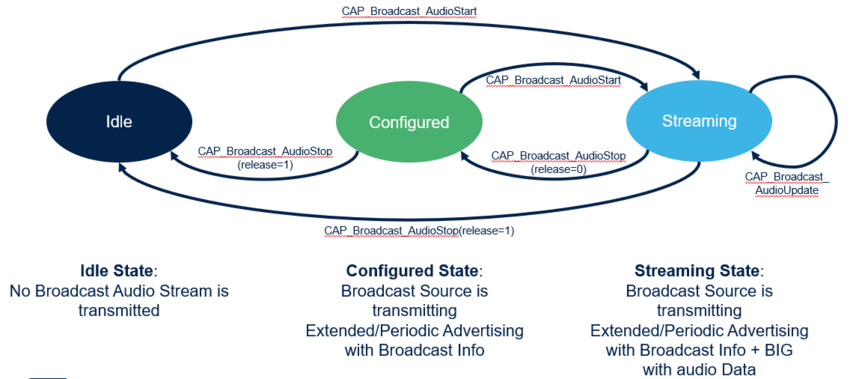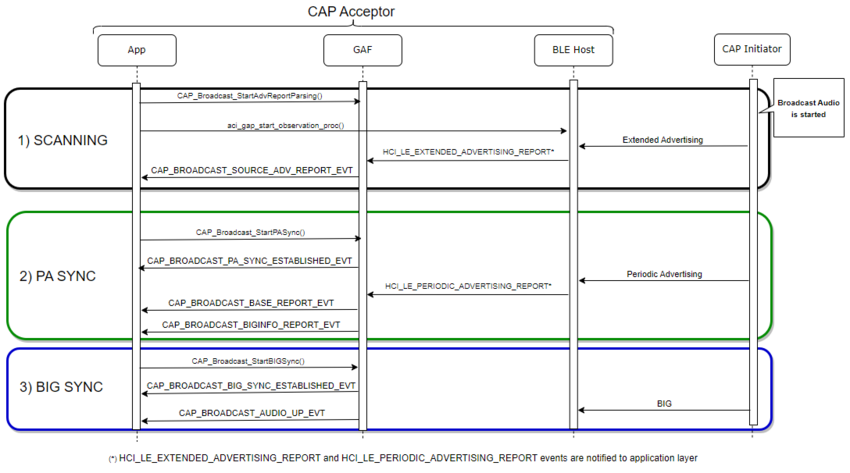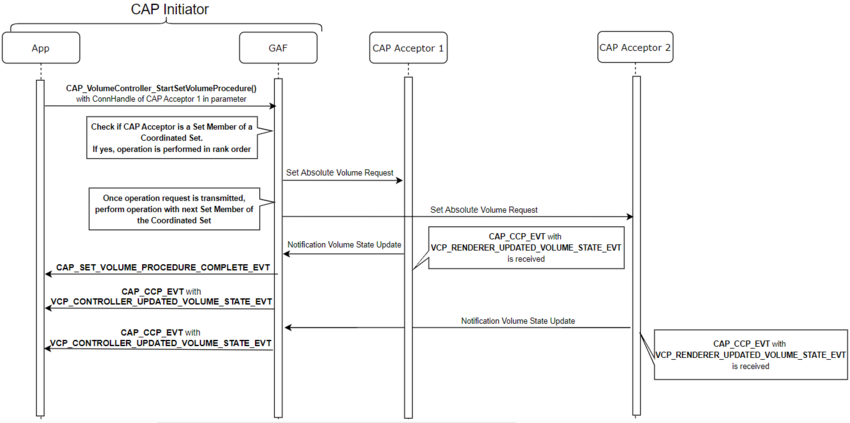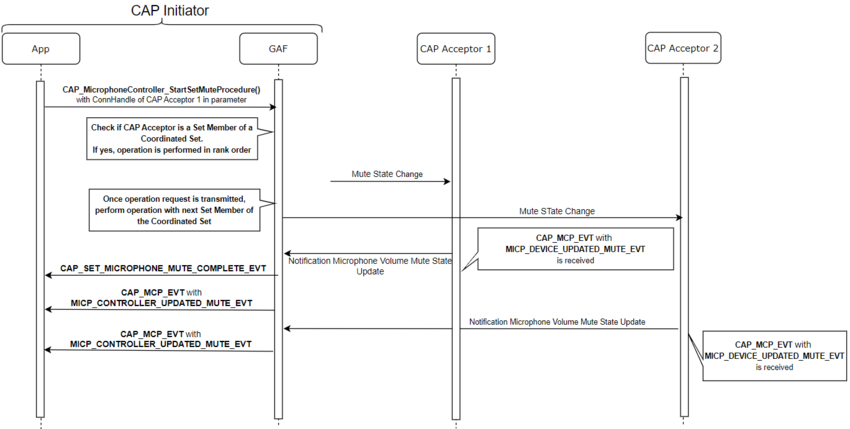1. STM32WBA BLE Audio firmware architecture
The Bluetooth® LE Audio firmware, as represented by the Bluetooth® Special Interest Group (Bluetooth® SIG), is composed to two layers:
- Profiles grouped in a block called Generic Audio Framework (BAP, MCP, CCP...). This layer is responsible to offer to the Audio Use Case profiles all the features required to implement an audio application based on the Bluetooth® LE.
- Profiles dedicated to the specific Audio Use Case (PBP: Published Broadcast Profile, HAP: Hearing Aids Profile...). This part is closed to the final audio application and interact with the Generic Audio Framework.
The single Core Arm® Cortex®-M33 STM32WBA Bluetooth® LE solution [1] is designed to develop audio application firmware based on Audio Use Case profiles on top of the Generic Audio Framework.
The Generic Audio Framework is on top of the Bluetooth® LE Firmware Stack (Controller & host) and offers Audio Stream Management service access and Remote Control service access.
1.1. Bluetooth® LE Audio Firmware package overview
STMicroelectronics provides, in the STM32CubeWBA MCU package, a software solution to develop audio application.
The Figure 1.1 represents the firmware architecture of the Bluetooth® LE Audio provided in the STM32CubeWBA MCU package.
|
Figure 1.1 Bluetooth® LE Audio firmware architecture |
The audio use case profile implementation is available insource code format in each Audio project assigned to an audio application based on a specific Audio Use Case as defined by the Bluetooth® SIG.
The Generic Audio Framework is included in an entity named "BLE Audio Stack" which includes:
- The entire Generic Audio Framework
- Audio utils (Audio Timer service, RAM allocation utils)
- Audio management is in charge of handling internal tasks and Bluetooth® Low Energy events received from the LE Host Stack.
The Bluetooth® LE Audio Stack is delivered in library format:
- The library is available in the \Middlewares\ST\STM32_WPAN\ble\audio\lib directory.
- The header files declaring the types and the APIs are available in the \Middlewares\ST\STM32_WPAN\ble\audio\Inc directory
|
Figure 1.2 STM32WBA Bluetooth® package overview |
1.2. Bluetooth® LE Audio Framework interfaces
The Header files associated to the Bluetooth® LE Audio Stack are described in the Table 1.1. The files are located in the \Middlewares\ST\STM32_WPAN\ble\audio\Inc directory.
| File Name | Description |
|---|---|
| audio_types.h | this file defines types for Bluetooth® LE Audio as specified by the Bluetooth SIG |
| ble_audio_stack.h | this file defines Bluetooth® LE Audio Stack interfaces initialization, task processing, database management, ATT procedure management |
| ble_audio_plat.h | this file defines types and declares the APIs required for Audio Stack integration on the platform: AES, RNG, nonvolatile memory, timer, traces |
| cap_types.h | This file defines:
|
| cap.h | This file declares functions to manage procedures defined by the Common Audio Profile. |
| bap_bufsize.h | This file defines MACROs to calculate the number of GATT services, GATT attributes, and ATT array size allocation required to support a Basic Audio Profile configuration. |
| bap_types.h | This file defines specific Basic Audio Profile types. |
| ltv_utils.h | This file declares functions to parse information included in the LTV structure. |
| ccp_types.h | This file defines:
|
| ccp.h | This file declares functions to manage call control operations. |
| mcp_types.h | This file defines:
|
| mcp.h | This file declares functions to manage media control operations. |
| csip_types.h | This file defines:
|
| csip.h | This file declares the function to register service instance for CSIP Set Member role. |
| micp_types.h | This file defines:
|
| micp.h | This file declares the function to manage microphone control operations not handled in CAP procedures. |
| vcp_types.h | This file defines:
|
| vcp.h | This file declares the function to manage volume control operations not handle in CAP procedures. |
Table 1.1 Header Files of the Generic Audio Framework'
The Figure 1.3 represents the Header files of the Generic Audio Framework.
|
Figure 1.3 STM32WBA Bluetooth® Header files of the Generic Audio Framework |
2. Bluetooth® LE Audio Stack integration
The base of the Bluetooth® LE Audio Stack is the Bluetooth® LE host and the Link Layer.
In addition, the Bluetooth® LE Audio Stack requires external software modules:
- Service Controller module
- Linked List Manager module
- Debug/Traces module
- Timer Server module
- Bare Metal Sequencer / Operation System module
- Nonvolatile Memory Manager module
- Advanced Encryption Standard (AES) module
- Random Number Generator module
The Figure 2.1 shows the external software modules dependencies of the Bluetooth® LE Audio Stack
|
Figure 2.1 STM32WBA Bluetooth® Bluetooth® LE Audio Stack integration dependencies |
2.1. Host Stack
The Basic Audio Profile of the Generic Audio Framework, included in the Bluetooth® LE Audio Stack, is in charge to manage features based on:
- Extended Advertising features
- ISO features
- Periodic Advertising features
- Periodic Advertising Sync Transfer features
These feature accesses are provided by the Bluetooth® LE Host Stack.
Moreover, all the profiles, and their associated services, in the Generic Audio Framework are based on the ATT service model. Consequently, each profile requires an access to GATT operations. These GATT operation accesses are provided by the Bluetooth® LE Host Stack.
2.2. Service Controller
The Service Controller, located in the Middlewares\ST\STM32_WPAN\ble\svc folder, is a software block used by the Bluetooth® LE Audio Stack to register handlers through which asynchronous HCI, GAP, and GATT events would be notified from the Bluetooth® LE Host to the profiles of the Generic Audio Framework.
In the Bluetooth® LE Audio Stack, a centric Audio Manager block is responsible to submit the events to the profiles of the Generic Audio Framework. For this reason, the Bluetooth® LE Audio Stack integration requires for the Service Controller configuration:
- BLE_CFG_SVC_MAX_NBR_CB shall be incremented by 1
- BLE_CFG_MAX_NBR_CB shall be incremented by 1
The Figure 2.2 shows the interface between the Bluetooth® LE Audio Stack and the Service Controller block. The Bluetooth® LE Audio Stack calls the SVCCTL_RegisterHandler() and SVCCTL_RegisterSvcHandler() functions to register event handlers.
|
Figure 2.2 Bluetooth® LE Audio Stack integration dependency - Service Controller module |
2.3. Linked List Manager
The Linked List Manager offers functions and types used by the Bluetooth® LE Audio Stack to handle its internal linked lists.
The List Manager functions are implemented in a file named stm_list.c and the List Manager types and APIs are declared in stm_list.h. These files are present in the Projects\Common\WPAN\Modules folder directory or in each project folder (depending of the COMMON_WPAN configuration).
The Figure 2.3 shows an interface between the Bluetooth® LE Audio Stack and the Linked List Manager block.
|
Figure 2.3 Bluetooth® LE Audio Stack integration dependency - Linked List manager module |
2.4. Debug/Traces
The Debug Traces IP is useful for the Bluetooth® LE Audio Stack in case of debug reports are enabled in the library.
For this, the Bluetooth® LE Audio Stack requests the system to print some debug traces thanks to the BLE_AUDIO_PLAT_DbgLog() API. This API shall be implemented in the project.
The Figure 2.4 shows an interface between the Bluetooth® LE Audio Stack and the debug traces block.
|
Figure 2.4 Bluetooth® LE Audio Stack integration dependency - Debug/Traces module |
The Bluetooth® LE Audio Trace BLE_AUDIO_PLAT_DbgLog() API (see Table 2.1) is declared in ble_audio_plat.h header file in the Middlewares\ST\STM32_WPAN\ble\audio\Inc folder.
| Functions | Header File |
|---|---|
| void BLE_AUDIO_PLAT_DbgLog(char *format,...) | ble_audio_plat.h |
Table 2.1 Bluetooth® LE Audio Debug Log porting function
2.5. Timer Server
The Bluetooth® LE Audio Stack requires a One-Shot Reference timer on which are multiplexed all the internal Bluetooth® LE Audio Software timers.
The Bluetooth® LE Audio Stack calls the BLE_AUDIO_PLAT_TimerStart() to create the reference timer and start it.
When the Bluetooth® LE Audio Stack needs to stop the timer, it calls the BLE_AUDIO_PLAT_TimerStop().
The Bluetooth® LE Audio Stack requires to get the remaining time of the reference timer. For this, it calls the BLE_AUDIO_PLAT_TimerGetRemainMs().
The Reference Timer expiration should be notified, from the system layer, in a background task, thanks to the callback function passed in the parameter of the BLE_AUDIO_PLAT_TimerStart() API.
These APIs shall be implemented in the project.
The Figure 2.5 shows the interface between the Bluetooth® LE Audio Stack and the Timer Server block.
|
Figure 2.5 Bluetooth® LE Audio Stack integration dependency - Timer Server module |
The Bluetooth® LE Audio Timer APIs, listed in the Table 2.2, are declared in ble_audio_plat.h header file in the Middlewares\ST\STM32_WPAN\ble\audio\Inc folder.
| Functions | Header File |
|---|---|
| void BLE_AUDIO_PLAT_TimerStart(void *pCallbackFunc,void *pParam,uint32_t Timeout) | ble_audio_plat.h |
| void BLE_AUDIO_PLAT_TimerStop(void) | ble_audio_plat.h |
| uint32_t BLE_AUDIO_PLAT_TimerGetRemainMs(void) | ble_audio_plat.h |
Table 2.2 Bluetooth® LE Audio Timer porting functions
2.6. Bare Metal Sequencer / Operating System
The Bluetooth® LE Audio Stack requires the registration of a dedicated Task responsible to run the internal Bluetooth® LE Audio profiles process.
The dedicated Task should call the BLE_AUDIO_STACK_Task() function.
When the Bluetooth® LE audio task requests to be executed, the Bluetooth® LE Audio Stack calls the BLE_AUDIO_STACK_NotifyToRun() to notify the system that the BLE_AUDIO_STACK_Task() function should be executed.
Note the BLE_AUDIO_STACK_Task() shall not be executed in the BLE_AUDIO_STACK_NotifyToRun() context.
The Bluetooth® LE Audio Process Stack is initialized with the BLE_AUDIO_STACK_Init() API call.
The BLE_AUDIO_STACK_NotifyToRun() API shall be implemented in the project.
TheFigure 2.6 shows the interface between the Bluetooth® LE Audio Stack and the Operating System block.
|
Figure 2.6 Bluetooth® LE Audio Stack integration dependency - Bare Metal Sequencer / operating System |
The Bluetooth® LE Audio Stack Sequencer and Initialization APIs, listed in the Table 2.3, are declared in ble_audio_stack.h header file in the Middlewares\ST\STM32_WPAN\ble\audio\Inc folder.
| Functions | Header File |
|---|---|
| void BLE_AUDIO_STACK_Init(void) | ble_audio_stack.h |
| void BLE_AUDIO_STACK_NotifyToRun(void) | ble_audio_stack.h |
| void BLE_AUDIO_STACK_Task(void) | ble_audio_stack.h |
Table 2.3 Bluetooth® LE Audio Task porting functions
2.7. Nonvolatile Memory Manager
The Bluetooth® LE Audio Stack requires Nonvolatile memory services access to manage Bluetooth® LE audio databases associated to the ATT services of the Bluetooth® LE Audio profiles composing the Generic Audio Framework.
The interfaces between the Bluetooth® LE Audio Stack and the Nonvolatile Memory services block has changed since the STM32CubeWBA Firmware Package V1.7.0. This package includes the new Bluetooth® LE Audio Library v1.11 introducing new Nonvolatile memory access protocol.
2.7.1. Nonvolatile Memory Manager until STM32Cube_FW_WBA_V1.6.1
The Bluetooth® LE Audio Stack requires functions to read/write/compare/erase information in nonvolatile memory. For this, the Bluetooth® LE Audio Stack calls the following APIs:
- BLE_AUDIO_PLAT_NvmAdd()
- BLE_AUDIO_PLAT_NvmGet()
- BLE_AUDIO_PLAT_NvmCompare()
- BLE_AUDIO_PLAT_NvmDiscard()
These APIs shall be implemented in the project.
To retrieve data stored in nonvolatile memory dedicated to each profile included in the Generic Audio Framework, the Bluetooth® LE Audio Stack enumerates specific NVM types (in ble_audio_if.h header file) in addition to the types declared in ble_plat.h for the Bluetooth® LE Host (BLEPLAT_NVM_TYPE_SEC & BLEPLAT_NVM_TYPE_GATT):
enum
{
BLEAUDIO_PLAT_NVM_TYPE_BAP_PACS = 2,
BLEAUDIO_PLAT_NVM_TYPE_BAP_ASCS = 3,
BLEAUDIO_PLAT_NVM_TYPE_BAP_BASS = 4,
BLEAUDIO_PLAT_NVM_TYPE_CCP = 5,
BLEAUDIO_PLAT_NVM_TYPE_CSIP = 6,
BLEAUDIO_PLAT_NVM_TYPE_MCP = 7,
BLEAUDIO_PLAT_NVM_TYPE_VCP = 8,
BLEAUDIO_PLAT_NVM_TYPE_MICP = 9,
};
TheFigure 2.7 shows an interface between the Bluetooth® LE Audio Stack and the Nonvolatile Memory Manager block.
|
Figure 2.7 Bluetooth® LE Audio Stack integration dependency - Nonvolatile Memory Manager |
The Bluetooth® LE audio NVM APIs, listed in the Table 2.4, are declared in ble_audio_plat.h header file in the Middlewares\ST\STM32_WPAN\ble\audio\Inc folder.
| Functions | Header File |
|---|---|
| int BLE_AUDIO_PLAT_NvmAdd( uint8_t type,const uint8_t* data,uint16_t size,const uint8_t* extra_data,uint16_t extra_size ) | ble_audio_plat.h |
| int BLE_AUDIO_PLAT_NvmGet( uint8_t mode,uint8_t type,uint16_t offset,uint8_t* data,uint16_t size ) | ble_audio_plat.h |
| Int BLE_AUDIO_PLAT_NvmCompare( uint16_t offset,const uint8_t* data,uint16_t size ) | ble_audio_plat.h |
| Int BLE_AUDIO_PLAT_NvmDiscard( uint8_t mode) | ble_audio_plat.h |
Table 2.4 Bluetooth® LE audio NVM porting functions
2.7.2. Nonvolatile Memory Manager since STM32Cube_FW_WBA_V1.7.0
The BleAudioInit_t structure, used in parameter of the BLE_AUDIO_STACK_Init() function, includes two flags bleAudioStartRamAddress_NVM and total_buffer_size_NVM providing to the Bluetooth® LE Audio Stack a RAM buffer allocated in application layer. This RAM buffer is used by the Bluetooth® LE Audio Stack for all the BLE Audio Information Storage processes in nonvolatile memory.
Note : In case of audio information is present in nonvolatile memory at startup, the RAM buffer, set in the bleAudioStartRamAddress_NVM , shall include this information when the BLE_AUDIO_STACK_Init() function is called.
The Bluetooth® LE Audio Stack requires a function to store information in nonvolatile memory. For this, the Bluetooth® LE Audio Stack calls the API BLE_AUDIO_PLAT_NvmStore() defined in ble_audio_plat.h.
This API shall be implemented in the project.
The Bluetooth® LE audio APIs dedicated to NVM service, listed in the Table 2.4 bis, are declared in ble_audio_plat.h and ble_audio_stack.h header files in the Middlewares\ST\STM32_WPAN\ble\audio\Inc folder.
| Functions | Header File |
|---|---|
| tBleStatus BLE_AUDIO_STACK_Init(BleAudioInit_t *pBleAudioInit); | ble_audio_stack.h |
| void BLE_AUDIO_PLAT_NvmStore( const uint32_t* ptr,uint32_t size ) | ble_audio_plat.h |
Table 2.4 bis Bluetooth® LE audio Nonvolatile Memory porting functions
2.8. Advanced Encryption Standard module
The Coordinated Set Identification Profile in the Generic Audio Framework requires access of many Advanced Encryption Standard operations.
For this, the Bluetooth® LE Audio Stack calls the following APIs:
- BLE_AUDIO_PLAT_AesEcbEncrypt()
- BLE_AUDIO_PLAT_AesCmacSetKey()
- BLE_AUDIO_PLAT_AesCmacCompute()
These APIs shall be implemented in the project.
The Figure 2.8 shows the interface between the Bluetooth® LE Audio Stack and the AES block.
|
Figure 2.8 Bluetooth® LE Audio Stack integration dependency - Advanced Encryption Standard module |
The Bluetooth® LE audio AES APIs, listed in the Table 2.5, are declared in ble_audio_plat.h header file in the Middlewares\ST\STM32_WPAN\ble\audio\Inc folder.
| Functions | Header File |
|---|---|
| void BLE_AUDIO_PLAT_AesEcbEncrypt( const uint8_t* key,const uint8_t* input,uint8_t* output ) | ble_audio_plat.h |
| void BLE_AUDIO_PLAT_AesCmacSetKey( const uint8_t* key ) | ble_audio_plat.h |
| void BLE_AUDIO_PLAT_AesCmacCompute( const uint8_t* input,uint32_t input_length,uint8_t* output_tag ) | ble_audio_plat.h |
Table 2.5 Bluetooth® LE Audio AES porting functions
2.9. Random Number Generator module
The Coordinated Set Identification profile in the Generic Audio Framework requires random number access.
For this, the Bluetooth® LE Audio Stack calls the BLE_AUDIO_PLAT_RngGet() API.
This API shall be implemented in the project.
TheFigure 2.9 shows the interface between the Bluetooth® LE Audio Stack and the Random Number Generator block.
|
Figure 2.9 Bluetooth® LE Audio Stack integration dependency - Random Number Generator module |
The Bluetooth® LE audio RNG API, listed in the Table 2.6, is declared in ble_audio_plat.h header file in the Middlewares\ST\STM32_WPAN\ble\audio\Inc folder.
| Functions | Header File |
|---|---|
| void BLE_AUDIO_PLAT_RngGet( uint8_t n, uint32_t* val ) | ble_audio_plat.h |
Table 2.6 Bluetooth® LE audio RNG porting functions
3. Bluetooth® LE Audio Stack configuration
The Bluetooth® LE Audio Stack is delivered in a unique library supporting all the roles of profiles composing the Generic Audio Framework defined by the Bluetooth® SIG.
Nevertheless, the Audio Use Case profiles, and so the final audio application, are based on Common Audio Profile roles, as defined by the Bluetooth® SIG, which are limited to three types (CAP Acceptor, CAP Commander and CAP Initiator). Each CAP role is associated to specific roles in the subprofiles composing the Generic Audio Framework as shown in the Figure 3.1.
|
Figure 3.1 Generic Audio Framework- "CAP role /Profiles" Relationship |
Some mechanisms are available to configure the Bluetooth® LE Audio Stack, and so the Generic Audio Framework, for a specific usage as defined in the Use Case Profiles and so fit just the required ROM/RAM resource to support the application configuration.
3.1. Configuration of the Audio profiles of the Generic Audio Framework
The Bluetooth® LE Audio Stack library offers a dynamic configuration way of its internal Audio profiles.
Each Audio profile of the Generic Audio Framework in the Bluetooth® LE Audio library is independently configurable and the RAM required by each Audio profile context in the Bluetooth® Low Energy Audio Stack to support its specific configuration shall be allocated in the application layer according to the configuration settings.
The RAM context allocation and the configuration of each Audio profile of the Generic Audio Framework is performed with CAP_Init() function thanks to the following dedicated Audio profile configuration structure parameters:
- CAP_Config_t
- BAP_Config_t
- CCP_Config_t
- MCP_Config_t
- CSIP_Config_t
- VCP_Config_t
- MICP_Config_t
Each of these configuration structures is composed of:
- configuration setting fields (role, max number of Bluetooth® Low Energy links, specific Audio profiles settings)
- Settings of the RAM buffer allocated for profile context memory resource
3.1.1. Media Control Profile configuration example
The Figure 3.2 describes the field of the Media Control Profile (MCP) Configuration. The MCP_Config_t structure type is defined in the mcp_types.h
|
Figure 3.2 MCP_Config_t definition (mcp_types.h) |
In case of an Audio Use Case profile based on a CAP Acceptor role supporting the MCP feature (MCP Client role):
- the Role field shall be set to MCP_CLIENT_ROLE
- the MaxNumBleLinks shall be set to the maximum number of connections with remote CAP Initiators the CAP Acceptor would support.
- The Clt field shall be filled in which pStartRamAdd field shall points on a RAM allocated in the application layer.
3.1.2. Unicast Server (CAP Acceptor) configuration example
The Figure 3.3 shows the fields in the BAP_Config_t structure to configure when the Unicast Server feature is activated in the CAP Acceptor role. The BAP_Config_t structure type is defined in the bap_types.h
|
Figure 3.3 Fields of BAP_Config_t to configure in the Unicast Server role |
3.1.3. Unicast Client (CAP Initiator) configuration example
The Figure 3.4 shows the fields in the BAP_Config_t structure to configure when the Unicast Client feature is activated in the CAP Initiator role. The BAP_Config_t structure type is defined in the bap_types.h
|
Figure 3.4 Fields of BAP_Config_t to configure in the Unicast Client role |
3.1.4. Broadcast Sink (CAP Acceptor) configuration example
The Figure 3.5 shows the fields in the BAP_Config_t structure to configure when the Broadcast Sink feature is activated in the CAP Acceptor role. The BAP_Config_t structure type is defined in the bap_types.h
|
Figure 3.5 Fields of BAP_Config_t to configure in the Broadcast Sink role |
3.1.5. Broadcast Source (CAP Initiator) configuration example
The Figure 3.6 shows the fields in the BAP_Config_t structure to configure when the Broadcast Source feature is activated in CAP Initiator role. The BAP_Config_t structure type is defined in the bap_types.h
|
Figure 3.6 Fields of BAP_Config_t to configure in Broadcast Source role |
3.1.6. Scan Delegator (CAP Acceptor/ CAP Commander) configuration example
The Figure 3.7 shows the fields in the BAP_Config_t structure to configure when the Scan Delegator feature is activated in the CAP Acceptor or CAP Commander role. The BAP_Config_t structure type is defined in the bap_types.h
|
Figure 3.7 Fields of BAP_Config_t to configure in Scan Delegator role |
3.1.7. Broadcast Assistant (CAP Commander) configuration example
The Figure 3.8 shows the fields in the BAP_Config_t structure to configure when the Broadcast Sssistant feature is activated in the CAP Commander role. The BAP_Config_t structure type is defined in the bap_types.h
|
Figure 3.8 Fields of BAP_Config_t to configure in the Broadcast Assistant role |
3.2. RAM context allocation of the Audio profiles of the Generic Audio Framework
The context memory of the Audio profiles in the Generic Audio Framework is allocated in the application layer according to the specified Audio profile configuration submitted over the parameters of CAP_Init() API.
ManyMACRO and Constants are defined for each Audio profile to calculate the required RAM size for the context resource to support the specified configuration.
Example – Media Control Profile (mcp_types.h) Two macros are defined to calculate RAM size:
- BLE_MCP_CLT_TOTAL_BUFFER_SIZE() returns the amount of memory, in bytes, needed for the storage of data structures in the MCP Client.
- BLE_MCP_SRV_TOTAL_BUFFER_SIZE() returns the amount of memory, in bytes, needed for the storage of data structures in MCP Server
The Figure 3.9 shows RAM allocation to support the MCP Client and MCP Server role.
|
Figure 3.9 MCP RAM context' allocation |
Warning:
The values of the parameters of the MACRO shall be equal to the values of the fields submitted in the parameters of the Audio profiles configuration in CAP_Init().
In cases of the parameters do not match, the CAP_Init() could fail because the Audio Stack will fail to allocate the memory required by the Audio profile or the CAP_Init() could unused memory to allocate the context of the Audio profile.
3.3. GATT allocation of the Audio profiles of the Generic Audio Framework
Each Audio profile in the GATT Server role in the Generic Audio Framework requires GATT service and GATT attributes allocation.
These allocations are done through theBleStack_init_t type parameter of the BleStack_Init() API of the Bluetooth® Low Energy host stack.
MACRO and Constants are defined for each Audio profile to calculate the required number of GATT services and GATT attributes to support a specified Audio profile configuration.
Example – Media Control Profile (mcp_types.h)
- MCP_SRV_NUM_GATT_SERVICES(num_media_players) is defined to calculate the number of GATT services required to configure the server role of the Media Control Profile according to the number of Media Player instances which would be registered in the application layer.
- MCP_SRV_NUM_GATT_ATTRIBUTES(num_media_players,mcp_feature) is defined to calculate the number of GATT attributes required to configure the server role of the Media Control Profile according to the number of Media Player instances and the supported MCP option feature.
3.4. ROM optimization of the Bluetooth® LE Audio Stack
Because the Bluetooth® LE Audio Stack is delivered in a unique library, the library supports all the roles of the profiles of the Generic Audio Framework.
Consequently, if the final audio application is based on only limited Audio profiles and limited profiles role, a lot of code in the Bluetooth® LE Audio Stack is not used and this memory could not be assigned for the application layer implementation.
To limit the unused RAM in the Bluetooth® LE Audio Stack, a mechanism, based on weak function concept, has been integrated in the Bluetooth® LE Audio Stack. This mechanism allows overwriting, in the application layer, the functions implemented in the static library that will not be called in a specific use case.
In the Bluetooth® LE Audio Stack , many functions that generate a high ROM allocation for a specific Audio profile role have been identified and declared asweak function.
If the Audio profile role is not required/supported for the Bluetooth® LE Audio Use Case, the weak function is implemented in the application layer as an empty function. By the way, all the ROM allocation generated by the function in the Bluetooth® LE Audio Stack library is removed in the final Bluetooth® LE Audio Use Case implementation.
TheFigure 3.10 shows the weak function defined in the Bluetooth® LE Audio Stack for each role of the Audio profiles in the Generic Audio Framework.
|
Figure 3.10 WEAK functions in the Generic Audio Framework |
Example 1
For a Bluetooth® LE Audio Use Case which does not require the BAP unicast server role, the following functions should be overwritten, in application layer (cf ble_audio_if.c), to remove unused code in the Bluetooth® LE Audio Stack library as shown in Figure 3.11
|
Figure 3.11 ROM optimization if Unicast Server role not required |
Example 2
For a LE use case which does not require Media Control Server role, the following functions should be overwritten, in the application layer (cf be_audio_if.c), to remove unused code in the Bluetooth® LE Audio Stack library as shown in Figure 3.12
|
Figure 3.12 ROM optimization if MCP server role not required |
3.5. Memory Allocation required for Audio Information Database of the Bluetooth® LE Audio Stack
As mentionned before, the Bluetooth® LE Audio Stack requests to store information related to Audio profiles/services. For this, a RAM buffer must be provided by the application to the Bluetooth® LE Audio Stack thanks to the BLE_AUDIO_STACK_Init() parameter.
In order to dimension correctly the RAM Buffer dedicated for NVM, MACROs are defined in header files of the Generic Audio Framework as listed in the Table 3.1 :
| MACROs | Header File |
|---|---|
| BAP_ASCS_CLT_DB_BUFFER_SIZE() | bap_bufsize.h |
| BAP_PACS_CLT_DB_BUFFER_SIZE() | bap_bufsize.h |
| BAP_BASS_CLT_DB_BUFFER_SIZE() | bap_bufsize.h |
| BAP_ASCS_SRV_DB_BUFFER_SIZE() | bap_bufsize.h |
| BAP_PACS_SRV_DB_BUFFER_SIZE() | bap_bufsize.h |
| BLE_CCP_CLT_DB_BUFFER_SIZE() | ccp_types.h |
| BLE_MCP_CLT_DB_BUFFER_SIZE() | mcp_types.h |
| BLE_MICP_CTLR_DB_BUFFER_SIZE() | micp_types.h |
| BLE_CSIP_SET_MEMBER_DB_BUFFER_SIZE() | csip_types.h |
| BLE_CSIP_SET_COORDINATOR_DB_BUFFER_SIZE() | csip_types.h |
| BLE_VCP_CTLR_DB_BUFFER_SIZE() | vcp_types.h |
| BLE_AUDIO_DB_BUFFER_SIZE() | ble_audio_stack.h |
Table 3.1 Bluetooth® LE audio MACROs for NVM Allocation
The BLE_AUDIO_DB_BUFFER_SIZE() is dedicated to audio information storage for layers external to the Generic Audio Framework: for example Audio Use Cases such as Telephony and Media Audio Profile, Hearing Aids Profile. In this case, the application layer shall call specific APIs define in the ble_audio_stack.h to manage Audio information related to these external Profiles.
4. Bluetooth® LE audio stack interface
The Bluetooth® LE audio stack offers interfaces to the application layer to share resources used by the Generic Audio Framework with external layer such as Audio Use Cases Profiles implemented in application layer. These resources are the Audio Information database managed in the Generic Audio Framework and the ATT/EATT Bearers reserved during the ATT procedures linked to the GATT Client operations processed in the Generic Audio Framework.
4.1. Bluetooth® LE audio stack database interface
As mentioned in the previous chapters, a RAM buffer is provided by the application layer to the Bluetooth® LE audio stack thanks to the BLE_AUDIO_STACK_Init() function. Many MACROs defined in the header files of the Generic Audio Framework allows to calculate the required size of the RAM buffer to allocate in order to store Audio Information according to the number of bonded devices to store and the configuration of the Audio Profiles of the Generic Audio Framework supported by the application.
In addition, the Bluetooth® LE audio stack has the ability to manage other information in its database issued from external layer.
For this, a MACRO BLE_AUDIO_DB_BUFFER_SIZE() is defined in ble_audio_stack.h file to calculate the size to add to the RAM buffer in parameter of the BLE_AUDIO_STACK_Init() function ( cf bleAudioStartRamAddress_NVM flag) and the functions listed in the Table 4.1 are defined in the ble_audio_stack.h file in order to access to the database of the Generic Audio Framework from the application layer.
| functions | Header File |
|---|---|
| tBleStatus BLE_AUDIO_STACK_DB_AddRecord(uint8_t Type,uint8_t PeerAddressType,const uint8_t* pPeerAddress,const uint8_t* pData,uint16_t Size) | ble_audio_stack.h |
| tBleStatus BLE_AUDIO_STACK_DB_FindRecord(uint8_t Type,uint8_t PeerAddressType,const uint8_t* pPeerAddress) | ble_audio_stack.h |
| tBleStatus BLE_AUDIO_STACK_DB_GetRecord(uint8_t Type,uint8_t PeerAddressType,const uint8_t* pPeerAddress,uint8_t* pData,uint16_t MaxSize,uint16_t *Size) | ble_audio_stack.h |
| tBleStatus BLE_AUDIO_STACK_DB_RemoveRecord(uint8_t Type,uint8_t PeerAddressType,const uint8_t* pPeerAddress) | ble_audio_stack.h |
Table 4.1 Bluetooth® LE audio Database Functions for External information
The Bluetooth® LE audio stack provides also other functions to get information about the bonded audio devices and to remove bonded audio devices. These APIS, declared in the ble_audio_stack.h header file, are listed in the Table 4.2.
| functions | Header File |
|---|---|
| tBleStatus BLE_AUDIO_STACK_DB_ClearAllRecords(void) | ble_audio_stack.h |
| uint8_t BLE_AUDIO_STACK_DB_GetNumBondedDevices(void) | ble_audio_stack.h |
| tBleStatus BLE_AUDIO_STACK_DB_GetBondedDevices(uint8_t *NumBondedDevices,BLE_Audio_Bonded_Device_Entry_t *pBondedDevice,uint8_t MaxNumBondedDevices) | ble_audio_stack.h |
| tBleStatus BLE_AUDIO_STACK_DB_CheckBondedDevice(uint8_t PeerAddressType, const uint8_t* pPeerAddress) | ble_audio_stack.h |
| tBleStatus BLE_AUDIO_STACK_DB_RemoveBondedDevice(uint8_t PeerAddressType,const uint8_t* pPeerAddress) | ble_audio_stack.h |
Table 4.2 Bluetooth® LE audio Database Functions
4.2. Bluetooth® LE audio stack ATT/EATT interface
Since the Bluetooth® LE audio Audio Stack v1.11 introduced in the STM32CubeWBA Firmware Package V1.7.0, the Bluetooth® LE audio Audio Stack supports the Enhanced ATT Feature.
The Bluetooth® LE Host Stack shall be configured to enable and support the EATT feature. Refer to STM32WB-WBA Enhanced ATT for activation of EATT Feature and creation of EATT Bearer.
WARNING : If EATT feature is supported in the application, the flag NumOfEATTBearersPerLink of the BleAudioInit_t used in parameter of the BLE_AUDIO_STACK_Init() function shall be set to the maximum number of EATT Bearers supported per ACL Link. In case of the flag value is lower thank the number of created EATT Bearers, critical issues could happen in the Generic Audio Framework.
In the subparts below, we will describe the interfaces of the Bluetooth® LE audio Audio Stack to manage resource required for GATT Client operations associated to Unenhanced ATT Bearer and Enhanced ATT Bearer.
4.2.1. Unenhanced ATT Bearer Resource Management interface
The Unenhanced ATT Bearer is a unique bearer per ACL Link used by the Bluetooth® LE Host Stack and so by the Bluetooth® LE audio Audio Stack to run ATT procedure. This ATT Bearer is reserved by the Generic Audio Framework when an ATT procedure associated to a GATT Client operation issued from an internal profile is started. Then, this ATT Bearer is freed once the procedure is complete (The Host Stack reports the ACI_GATT_PROC_COMPLETE_EVENT event).
As shown in Figure 4.1, the BLE_AUDIO_STACK_ATTProcedureRegistrationUpdated() callback function is called by the Bluetooth® LE Host Stack each time the Unenhanced ATT Bearer is reserved to perform an ATT procedure for a GATT Client Operation and freed once the ATT procedure is complete. This function could be implemented in application layer to be informed about the availability of the Unenhanced ATT Bearer.
|
Figure 4.1 ATT Bearer Registration from Generic Audio Framework |
Because the ATT Bearer resource needs to be share by all the layer of the application (for example Audio Use Case Profiles, Generic Audio Framework), the Bluetooth® LE audio Audio Stack provides the APIs listed in the Table 4.3 to ensure ATT Bearer resource sharing between the Generic Audio Framework and the other layers.
| functions | Header File |
|---|---|
| tBleStatus BLE_AUDIO_STACK_ATT_RegisterATTProcedure(uint16_t ACL_ConnHandle,uint8_t ProcedureID) | ble_audio_stack.h |
| tBleStatus BLE_AUDIO_STACK_ATT_UnregisterATTProcedure(uint16_t ACL_ConnHandle,uint8_t ProcedureID) | ble_audio_stack.h |
| tBleStatus BLE_AUDIO_STACK_ATT_IsRegisteredATTProcedure(uint16_t ACL_ConnHandle,uint8_t ProcedureID) | ble_audio_stack.h |
Table 4.3 Bluetooth® LE audio ATT Bearer Functions
The BLE_AUDIO_STACK_ATT_IsRegisteredATTProcedure() is used to check if the unenhanced ATT Bearer is registered/reserved for an ATT procedure in progress initiated by the Generic Audio Framework or an external GATT Client layer. The BLE_AUDIO_STACK_ATT_RegisterATTProcedure() is called when a GATT Client operation is started successfully. This function allows to
reserve the ATT Bearer during the ATT procedure and inform the Generic Audio Framework that the ATT Bearer is in used and so any internal GATT Client Operation should be delayed.
Once the operation is complete, the Host Stack reports the ACI_GATT_PROC_COMPLETE_EVENT event. The BLE_AUDIO_STACK_ATT_IsRegisteredATTProcedure() could be called to check if the ATT Bearer is reserved for the expected ATT procedure (specified by a ProcedureID identifier). In order to freed the ATT Bearer for other layer, the BLE_AUDIO_STACK_ATT_UnregisterATTProcedure() shall be called.
|
Figure 4.2 ATT Bearer Registration from Application Layer |
4.2.2. Enhanced ATT Bearers Resource Management interface
Multiple Enhanced ATT Bearers could be created per ACL Link and could be used by the Bluetooth® LE Host Stack and so by the Bluetooth® LE Audio Stack to run ATT procedure.
All the created EATT Bearers are independently registered in the Generic Audio Framework in order to allow it to manage an ATT procedure associated to an EATT Bearer issued from a remote device.
The Bluetooth® LE Audio Stack provides a functionBLE_AUDIO_STACK_EATT_SubscribeBearers() allowing to specify to the Audio Stack the EATT Bearers which could be used by to perform the internal ATT procedures in GATT Client role and/or ATT Notification/Indication operations in GATT Server role : When the Audio Stack needs to run an ATT procedure, it will get an EATT Bearer is available and run the GATT operation on the associated Connection Oriented Channel.
In case of 5 EATT Bearers are created and User application calls BLE_AUDIO_STACK_EATT_SubscribeBearers() for only 3 of them, the remaining 2 EATT Bearers will never be used by the Bluetooth® LE Audio Stack to perform ATT procedure (except if the remote device run an ATT procedure associated to one of these EATT Bearers). Consequently, the remaining EATT Bearers could be reserved for other GATT layers.
As shown in Figure 4.3, the BLE_AUDIO_STACK_ATTProcedureRegistrationUpdated() callback function is called by the Bluetooth® LE Host Stack each time an EATT Bearer is reserved to perform an ATT procedure for a GATT Client Operation and freed once the ATT procedure is complete. This function could be implemented in application layer to be informed about the availability of an EATT Bearer.
|
Figure 4.3 EATT Bearer Registration from Generic Audio Framework |
Because the EATT Bearer resource could be shared with other layer of the application (for example Audio Use Case Profiles), the Bluetooth® LE audio Audio Stack provides the APIs listed in the Table 4.4 to ensure EATT Bearer resource sharing between the Generic Audio Framework and the other layers.
| functions | Header File |
|---|---|
| tBleStatus BLE_AUDIO_STACK_EATT_SubscribeBearers(uint8_t *pChannel_Index,uint8_t NumEATTBearers) | ble_audio_stack.h |
| tBleStatus BLE_AUDIO_STACK_EATT_IsSubscribedBearer(uint8_t Channel_Index) | ble_audio_stack.h |
| uint8_t BLE_AUDIO_STACK_EATT_GetNumSubscribedBearers(uint16_t ACL_ConnHandle) | ble_audio_stack.h |
| tBleStatus BLE_AUDIO_STACK_EATT_GetAvailableBearer(uint16_t ACL_ConnHandle,uint8_t *Channel_Index) | ble_audio_stack.h |
| tBleStatus BLE_AUDIO_STACK_EATT_RegisterATTProcedure(uint8_t Channel_Index,uint8_t ProcedureID) | ble_audio_stack.h |
| tBleStatus BLE_AUDIO_STACK_EATT_UnregisterATTProcedure(uint8_t Channel_Index,uint8_t ProcedureID) | ble_audio_stack.h |
| tBleStatus BLE_AUDIO_STACK_EATT_IsBearerRegisteredATTProcedure(uint8_t Channel_Index,uint8_t ProcedureID) | ble_audio_stack.h |
| tBleStatus BLE_AUDIO_STACK_EATT_IsRegisteredATTProcedure(uint16_t ACL_ConnHandle,uint8_t ProcedureID) | ble_audio_stack.h |
Table 4.4 Bluetooth® LE audio EATT Bearer Functions
The BLE_AUDIO_STACK_EATT_IsRegisteredATTProcedure() function is used to check if an ATT procedure is registered for one of the subscribed EATT Bearers associated to an ACL Link. The BLE_AUDIO_STACK_EATT_IsBearerRegisteredATTProcedure() function is used to check if an EATT Bearer is registered/reserved for an ATT procedure in progress initiated by the Generic Audio Framework or an external GATT Client layer.
The BLE_AUDIO_STACK_EATT_GetAvailableBearer() function is called when the Application needs to get an available EATT Bearer to perform an ATT procedure. In case of the ATT procedure associated to a GATT Client operation is started successsfully, the BLE_AUDIO_STACK_EATT_RegisterATTProcedure() is called to reserve the EATT Bearer during the ATT procedure and inform the Generic Audio Framework that the EATT Bearer is in used.
Once the operation is complete, the Host Stack reports the ACI_GATT_PROC_COMPLETE_EVENT event. The BLE_AUDIO_STACK_EATT_IsBearerRegisteredATTProcedure() could be called to check if the EATT Bearer is reserved for the expected ATT procedure (specified by a ProcedureID identifier). In order to freed the EATT Bearer for other layer, the BLE_AUDIO_STACK_EATT_UnregisterATTProcedure() shall be called.
|
Figure 4.4 EATT Bearer Registration from Application Layer |
5. Bluetooth® LE Generic Audio Framework procedures
This section describes the main procedures handled by the CAP layer of the Generic Audio Framework:
- Audio profiles of the Generic Audio Framework Linkup procedure
- Unicast Audio procedures
- Broadcast Audio procedures
- Capture and Cendering Control procedures
5.1. Audio profiles linkup
The Audio profiles link up procedures, described in this section, consist to discover the services and the associated characteristics of the Audio profiles composing the Generic Audio Framework of the remote Bluetooth device.
The Generic Audio Framework implements a CAP Linkup procedure, initiated by calling the CAP_Linkup() function (defined in cap.h), that shall be called to discover/link the Audio profiles supported by the remote CAP device. The linkup procedure shall be called only if the link with the remote device is encrypted.
The CAP_Linkup() function performs a linkup operation on profiles composing the Generic Audio Framework, according to the input parameter type GAF_Profiles_Link_t. The linkup operation could be a complete link process (e.g: Service and characteristic discovery) or just a service restoration from information stored in the nonvolatile memory.
This function could be called by any of the CAP roles in a GATT Client role for an Audio profile. For example, a CAP Initiator could try to perform a linkup procedure for profiles associated to the Unicast feature and for the Coordinated Set Identification Profile because the CAP Initiator could be BAP Unicast Client and CSIP Set Coordinator. However, it could not perform linkup of Call Control Profile because the CAP Initiator could be only the call control server (GATT server role) for this profile.
On the other side, the CAP Acceptor could performed linkup procedure of Call Control Profile and Media Control Profile with a remote CAP Initiator
TheCAP_DB_GetPresentGAFProfiles() function enables to get the profiles of the Generic Audio Framework that are present/saved in nonvolatile memory for a specific Bluetooth device.
TheCAP_GetCurrentLinkedProfiles() function enables to get the current linked profiles of the Generic Audio Framework issued from a previous CAP linkup procedure.
TheCAP_Unlink() function enables to unlink specified profiles of the Generic Audio Framework of a current connection and to indicate if the associated information should be stored in the nonvolatile memory.
TheCAP_DB_StoreGAFProfiles() function stores in nonvolatile memory the information related to the Audio profiles composing the Generic Audio Framework issued from local or remote service link process.
| Functions | Description | Header File |
|---|---|---|
| CAP_Linkup() | Perform Linkup operation on specified profiles composing the Generic Audio Framework. If a profile is already linked, the function returns a failure status. |
cap.h |
| CAP_DB_GetPresentGAFProfiles() | Indicate the profiles in ATT Client role of the Generic Audio Framework present in the nonvolatile memory. | cap.h |
| CAP_GetCurrentLinkedProfiles() | Indicate the linked profiles of the Generic Audio Framework issued from a CAP linkup procedure. | cap.h |
| CAP_Unlink() | Unlink the linked profiles of the Generic Audio Framework issued from a previous CAP linkup procedure. | cap.h |
| CAP_DB_StoreGAFProfiles() | Store in Non Volatile Memory the information related to the Audio profiles composing the Generic Audio Framework issued from local or remote service link process. | cap.h |
The events CAP_CSI_LINKUP_EVT, CAP_UNICAST_LINKUP_EVT, CAP_BA_LINKUP_EVT , CAP_CCP_LINKUP_EVT, CAP_MCP_LINKUP_EVT, CAP_CSI_LINKUP_EVT, CAP_VOLUME_CTRL_LINKUP_EVT and CAP_MICROPHONE_CTRL_LINKUP_EVT may be notified during the CAP linkup procedure depending on requested Audio profiles and if they are supported by the remote device.
The CAP_LINKUP_COMPLETE_EVT event is notified once CAP procedure is complete. These events are listed in the Table 5.1 .
| Events | Description | Header File |
|---|---|---|
| CAP_UNICAST_LINKUP_EVT | Event notified during CAP linkup procedure if CAP Initiator supports BAP Unicast Client role and discovers that the remote device supports BAP Unicast Server role. | cap_types.h |
| CAP_CSI_LINKUP_EVT | Event notified during CAP linkup procedure if CAP Initiator/Commander supports CSIP Set Coordinator role and discovers that the remote device supports CSIP Set Member role. | cap_types.h |
| CAP_BA_LINKUP_EVT | Event notified during CAP linkup procedure if CAP Commander supports BAP Broadcast Assistant role and discovers that the remote device supports Scan Delegator role. | cap_types.h |
| CAP_CCP_LINKUP_EVT | Event notified during CAP linkup procedure if CAP Commander or CAP Acceptor supports Call Control Client role and discovers that the remote device supports CCP Server role. | cap_types.h |
| CAP_MCP_LINKUP_EVT | Event notified during CAP linkup procedure if CAP Commander or CAP Acceptor supports Media Control Client role and discovers that the remote device supports MCP Server role. | cap_types.h |
| CAP_VOLUME_CTRL_LINKUP_EVT | Event notified during CAP linkup procedure if CAP Commander supports the VCP Volume Controller role and discovers that the remote device supports the VCP Volume Renderer role. | cap_types.h |
| CAP_MICROPHONE_CTRL_LINKUP_EVT | Event notified during CAP linkup procedure if CAP Commander supports MICP Microphone Controller role and discovers that the remote device supports MICP Microphone Device role. | cap_types.h |
| CAP_LINKUP_COMPLETE_EVT | Event notified once CAP Linkup is complete. | cap_types.h |
Table 5.1 CAP events reported during CAP Linkup procedure
In case of the remote CAP Acceptor is a Set Member of a Coordinated Set, the local CAP Initiator or CAP Commander should discover and performs the CAP Linkup procedure with other CAP Acceptors of the Coordinated Set.
The Figure 5.1 shows an example of an implementation to perform CAP Linkup with all CAP Acceptors of a Coordinated Set.
- Connect with the first CAP Acceptor (thanks to aci_gap_ext_create_connection() or aci_gap_create_connection())
- When the LE Connection Complete event is received, call the aci_gap_send_pairing_req() to pair or directly start encryption with the remote CAP Acceptor
- When the Pairing Complete event is received, CAP_Linkup() function is called to linkup with remote supported Audio profiles composing the Generic Audio Framework.
- When the CAP linkup process is complete (CAP_LINKUP_COMPLETE_EVT event notification), if CAP_CSI_LINKUP_EVT event has been received during the process indicating that the connected CAP Acceptor is a Set Member of a Coordinated Set, the aci_gap_ext_start_scan() (or aci_gap_start_general_connection_establish_proc()) and CAP_StartCoordinatedSetMemberDiscoveryProcedure() could be called to discover the other CAP Acceptors composing the Coordinated Set of the first CAP Acceptor. Note that the CAP_CSI_LINKUP_EVT enables to know, if supported by the CAP Acceptor, the size of the Coordinated Set and the rank of the CAP Acceptor.
- When a CAP Acceptor of the Coordinated Set in Advertising state is discovered, the CSIP_COO_ADV_REPORT_NEW_SET_MEMBER_DISCOVERED_EVT event is notified. At this moment, the aci_gap_ext_create_connection() (or aci_gap_create_connection()) could be called to connect with the discovered CAP Acceptor.
- When the LE Connection Complete event is received, call the aci_gap_send_pairing_req() to pair or directly start encryption with the remote CAP Acceptor.
- Once the CSIP Set Member discovery process is complete (Matching of SIR process), the CSIP_COO_NEW_SET_MEMBER_DISCOVERED_EVT is received.
- In case of another CAP Acceptor is discovered, CSIP_COO_ADV_REPORT_NEW_SET_MEMBER_DISCOVERED_EVT event is notified and connection + pairing should be performed for each discovered CAP Acceptor
- Once the Set Member Discovery procedure is complete (All Set Members have been discovered or timeout), the CSIP_COO_SET_MEMBER_DISCOVERY_PROCEDURE_COMPLETE_EVT event is received.
- The CAP_Linkup() should be performed for each discovered CAP Acceptor once the Set Member Discovery procedure is complete
|
Figure 5.1 CAP Linkup with all CAP Acceptors of a Coordinated Set |
According the the Bluetooth SIG specification, information related to the profiles composing the Generic Audio Framework shall be saved in Nonvolatile Memory if devices are bonded. The Audio profiles information is saved per active connection at the time of disconnection.
Moreover, the Generic Audio Framework offers the CAP_DB_StoreGAFProfiles() function (defined in cap.h) allowing the User to store in Nonvolatile Memory the information related to the Audio profiles at anytime during a connection. This function call could be associated to the aci_gatt_store_db() function call (defined in ble_gatt_aci.h).These functions are useful when a turn off or a reset of the board is detected while a connection is still up.
Concerning information related to Audio Use Case profiles, the Nonvolatile Memory Storage management in managed in application layer.
5.2. Audio Stream Transition procedures
The procedures associated to the Audio Stream Transition are specified in the section 7.3.1 of the Common Audio Profile[2]
5.2.1. Unicast Audio procedures
The Unicast Audio procedures (Unicast Audio Start, Unicast Audio Stop, Unicast Audio Update) described in the CAP specification are performed by the CAP Initiator thanks to the function listed in the Table 5.2.
| Functions | Description | Header File |
|---|---|---|
| CAP_Unicast_AudioStart() | Start Unicast Audio with specified CAP Acceptors according to Sink/Source stream configuration. | cap.h |
| CAP_Unicast_AudioStop() | Stop Unicast Audio with specified CAP Acceptors. | cap.h |
| CAP_Unicast_AudioUpdate() | Change Context Type values and/or CCID values associated with one or more Unicast Audio Streams. | cap.h |
Table 5.2 Functions for Unicast Audio procedure management
ForCAP Acceptor supporting Unicast Server role, the Generic Audio Framework provides functions to :
- Register Sink/Source Audio Channels accessible by the remote CAP Initiator
- Set/Update the Audio Contexts (Conversational, media… Audio_Context_t defined in audio_types.h)
- Set/Update the Audio Locations (Front left, front right…Audio_Location_t defined in audio_types.h)
- Register/Update the Audio Capabilities of the Unicast Server
The Table 5.3 describes the functions dedicated to the CAP Acceptor in the Unicast Server role.
| Functions | Description | Header File |
|---|---|---|
| CAP_RegisterAudioChannels() | Register Sink/Source Audio Channels (and associated Audio Stream Endpoint) supported by Unicast Server. | cap.h |
| CAP_SetSupportedAudioContexts() | Set/Update Supported Audio Contexts for reception and transmission. | cap.h |
| CAP_SetAvailableAudioContexts() | Set Available Audio Contexts for reception and transmission which will be used for BAP Announcement and for future connections. | cap.h |
| CAP_UpdateAvailableAudioContexts() | Update Available Audio Contexts for reception and transmission associated to the specified remote CAP device. | cap.h |
| CAP_SetSnkAudioLocations() | Set/Update the Supported Sink Audio Locations. | cap.h |
| CAP_SetSrcAudioLocations() | Set/Update the Supported Source Audio Locations. | cap.h |
| CAP_RegisterSnkPACRecord() | Register Published Audio Capabilities record for Audio Sink role. | cap.h |
| CAP_RegisterSrcPACRecord() | Register Published Audio Capabilities record for Audio Source role. | cap.h |
| CAP_UpdatePACRecord() | Update a registered Published Audio Capabilities record for Audio Sink/Source role. | cap.h |
Table 5.3 CAP functions dedicated to CAP Acceptor for Unicast Audio configuration
The section 3.5 of theBasic Audio Profile[3] describes the requirement of the CAP Acceptor in Unicast Server role concerning the Audio Capabilities configuration and the Audio Channels configuration to support according to the Audio role (sink and/or source) and the Audio Locations.
Note that each Bluetooth® LE Audio Use Case profile specifies its Audio Capabilities and Audio Channels requirements.
During the Unicast Audio Stream Transition procedure, the CAP Initiator and the CAP Acceptor receive CAP events described inTable 5.4.
| CAP procedure | Events | Description | CAP Initiator | CAP Acceptor |
|---|---|---|---|---|
| Audio Start | CAP_UNICAST_AUDIO_STARTED. | Unicast Audio Start procedure is complete with all the specified CAP Acceptors. | X | |
| Audio Start | CAP_UNICAST_PREFERRED_QOS_REQ_EVT | Preferred QoS settings are requested for the specified Audio Stream Endpoint. | X | |
| Audio start | CAP_UNICAST_AUDIO_DATA_PATH_SETUP_REQ_EVT | Audio data path setup is requested for the specified Audio Stream Endpoint. The CAP_Unicast_SetupAudioDataPath() shall be called to respond to the Audio Data Path Setup request. |
X | X |
| Audio Start | CAP_AUDIO_CLOCK_REQ_EVT | Audio Clock subsystem should be updated to support submitted audio sample frequency | X | X |
| Audio Start Audio Stop |
CAP_UNICAST_SERVER_ASE_STATE_EVT | The state of an Audio Stream Endpoint has changed in Unicast Server side (CAP Acceptor)
The state and the transition are described in the section 3 of the Audio Stream Control Service [4]'. |
X | |
| Audio Start Audio stop |
CAP_UNICAST_CLIENT_ASE_STATE_EVT | The state of an Audio Stream Endpoint has changed in Unicast Client side (CAP Initiator)
The state and the transition are described in the section 3 of the Audio Stream Control Service [4]'. |
X | |
| Audio Start | CAP_UNICAST_AUDIO_CONNECTION_UP_EVT | Audio path is up for specified Audio Stream Endpoint | X | X |
| Audio Start Audio stop |
CAP_UNICAST_AUDIO_CONNECTION_DOWN_EVT | Audio path is down for specified Audio Stream Endpoint | X | X |
| Audio Stop | CAP_UNICAST_AUDIO_STOPPED | Unicast Audio Stop procedure is complete with all the specified CAP Acceptors | X | |
| Audio Update | CAP_UNICAST_AUDIO_UPDATED | Unicast Audio Update procedure is complete with all the specified CAP Acceptors | X | |
| Audio Update | CAP_UNICAST_ASE_METADATA_UPDATED_EVT | Metadata associated to an Audio Stream Endpoint is updated but Audio Stream Endpoint State does not change | X | X |
Table 5.4 CAP events of Unicast Audio transition
TheFigure 5.2 shows the Functions/Events flow during the CAP Unicast Audio Start procedure in CAP Initiator and CAP Acceptor side. In this example, the CAP Initiator starts a bidirectional Unicast Audio with one CAP Acceptor. Consequently, a source ASE and a Sink ASE are used by the CAP Initiator to set up the Unicast Audio.
|
Figure 5.2 Unicast Audio start procedure sequence |
In case of a failure occurs during the Unicast Audio Start procedure, the CAP Initiator automatically aborts the procedure to move the Audio Stream Endpoints in IDLE or CODEC CONFIGURED state. Once the Abort operation is complete, the CAP_UNICAST_AUDIO_STARTED events with failure status are notified to the upper layer.
TheFigure 5.3 shows the Functions/Events flow during the CAP Unicast Audio Stop procedure in CAP Initiator and CAP Acceptor side. In this example, at the starting point, a source ASE and a Sink ASE are in Streaming state when the CAP Initiator calls the CAP_Unicast_AudioStop() function.
|
Figure 5.3 Unicast Audio stop procedure sequence |
5.2.2. Broadcast Audio procedures
The Broadcast Audio procedures (Broadcast Audio Start, Broadcast Audio Stop, Broadcast Audio Update) described in the CAP specification are performed by the CAP Initiator thanks to the functions listed in the Table 5.5.
| Functions | Description | Header File |
|---|---|---|
| CAP_Broadcast_AudioStart() | Configure and start a Broadcast Source with the given parameters. | cap.h |
| CAP_Broadcast_AudioStop() | Stop a Broadcast Source and go to configured or Idle State. | cap.h |
| CAP_Broadcast_AudioUpdate() | Update a streaming Broadcast Source Metadata Cannot change an audio configuration. |
cap.h |
Table 5.5 CAP functions of Broadcast Audio Transition management in the CAP Initiator side
During the CAP Broadcast Audio procedures, the CAP Initiator is notified, over CAP events, that the procedure is complete and the state of the audio path associated to the audio stream has changed. These events notified during the CAP Broadcast Audio Procedures are listed in theTable 5.6.
| Events | Description | Header File |
|---|---|---|
| CAP_BROADCAST_AUDIOSTARTED_EVT | Event notified when the broadcast Audio Start procedure is complete. | cap_types.h |
| CAP_BROADCAST_AUDIOSTOPPED_EVT | Event notified when the Broadcast Audio Stop procedure is complete. | cap_types.h |
| CAP_BROADCAST_AUDIO_UP_EVT | Event notified when the audio path has been set up. | cap_types.h |
| CAP_BROADCAST_AUDIO_UP_EVT | Event notified when the audio path has been removed. | cap_types.h |
Table 5.6 CAP events of Broadcast Audio Transition in CAP Initiator side
TheFigure 5.4 shows the Broadcast State Machine of the CAP Initiator in Broadcast Source role. The oval shapes represent the states of the CAP Initiator State Machine. The labeled arrows represent the CAP Broadcast functions, which can cause a transition of the state machine.
|
Figure 5.4 CAP Initiator Broadcast State Machine |
When a Broadcast Audio Stream is in progress, a CAP Acceptor, supporting Broadcast Sink role, which would be synchronized with the Broadcast Audio Stream needs to call successive Bluetooth® LE legacy functions and CAP functions to be able to be synchronized with the Broadcast Isochronous Stream emitted by a CAP Initiator. The CAP functions allowing the CAP Acceptor to manage Broadcast Audio Stream are listed in the Table 5.7.
| Functions | Description | Header File |
|---|---|---|
| CAP_Broadcast_StartAdvReportParsing() | Start parsing Extended Advertising events to look for Broadcast UUIDs and generate CAP_BROADCAST_SOURCE_ADV_REPORT_EVT events
An observation procedure must be started by the user in parallel. |
cap.h |
| CAP_Broadcast_StopAdvReportParsing() | Stop parsing Extended Advertising events. | cap.h |
| CAP_Broadcast_StartPASync() | Start synchronization to a Periodic Advertising train. | cap.h |
| CAP_Broadcast_StartBIGSync() | Start synchronization to a Broadcast Isochronous Group. | cap.h |
| CAP_Broadcast_StopPASync() | Stop synchronization to a Periodic Advertising train. | cap.h |
| CAP_Broadcast_StopBIGSync() | Stop synchronization to a Broadcast Isochronous Group. | cap.h |
| CAP_Broadcast_ParseBASEGroup() | Parse a BASE payload reported by a CAP_BROADCAST_BASE_REPORT_EVT and fill a BAP_BASE_Group_t structure. | cap.h |
| CAP_Broadcast_ParseBASESubgroup() | Parse a BASE payload reported by a CAP_BROADCAST_BASE_REPORT_EVT and fill a BAP_BASE_Subgroup_t structure. | cap.h |
| CAP_Broadcast_ParseBASEBIS() | Parse a BASE payload reported by a CAP_BROADCAST_BASE_REPORT_EVT and fill a BAP_BASE_BIS_t structure. | cap.h |
| CAP_Broadcast_IsBASEGroupDifferent() | Parse a BASE payload reported by a CAP_BROADCAST_BASE_REPORT_EVT and compare it with a BAP_BASE_Group_t structure. Returns 0 if they are the same, or a non-zero value if they differ. | cap.h |
| CAP_Broadcast_IsBASESubgroupDifferent() | Parse a BASE payload reported by a CAP_BROADCAST_BASE_REPORT_EVT and compare it with a BAP_BASE_Subgroup_t structure. Returns 0 if they are the same, or a non-zero value if they differ. | cap.h |
| CAP_Broadcast_IsBASEBISDifferent() | Parse a BASE payload reported by a CAP_BROADCAST_BASE_REPORT_EVT and compare it with a BAP_BASE_BIS_t structure. Returns 0 if they are the same, or a non-zero value if they differ. | cap.h |
Table 5.7 CAP functions of Broadcast Audio transition management in CAP Acceptor side
During the Broadcast Audio procedure in CAP Acceptor side, many CAP events are notified in the application layer resulting to operations started by the CAP Acceptor itself or the remote CAP Initiator. These CAP events received in the CAP Acceptor side are listed in the Table 5.8.
| Events | Description | Header File |
|---|---|---|
| CAP_BROADCAST_SOURCE_ADV_REPORT_EVT | Notified when a Broadcast Source has been scanned. | cap_types.h |
| CAP_BROADCAST_PA_SYNC_ESTABLISHED_EVT | Notified when synchronization to a Periodic Advertising train has been established. | cap_types.h |
| CAP_BROADCAST_BASE_REPORT_EVT | Notified when a BASE report is received. | cap_types.h |
| CAP_BROADCAST_BIGINFO_REPORT_EVT
|
Notified when a BIG Info is received. | cap_types.h |
| CAP_BROADCAST_BIG_SYNC_ESTABLISHED_EVT | Notified when synchronization to a BIG Info has been established. | cap_types.h |
| CAP_BROADCAST_PA_SYNC_LOST_EVT | Notified when synchronization to a Periodic Advertising train has been lost. | cap_types.h |
| CAP_BROADCAST_BIG_SYNC_LOST_EVT | Notified when synchronization to a BIG has been lost. | cap_types.h |
| CAP_BROADCAST_AUDIO_UP_EVT | Notified when audio data path has been set up. | cap_types.h |
| CAP_BROADCAST_AUDIO_DOWN_EVT | Notified when audio data path has been removed. | cap_types.h |
Table 5.8 CAP events of broadcast audio transition in CAP Acceptor side
TheFigure 5.5 describes the Broadcast Sink sequence diagram during the Broadcast Audio Stream synchronization procedure in CAP Acceptor side. To synchronize with Broadcast Audio Stream, successive CAP broadcast operations are required in the CAP Acceptor side.
|
Figure 5.5 CAP Acceptor Broadcast Sequence diagram |
5.3. Capture and Rendering Control procedures
The procedures associated to the Capture and Rendering Control are specified in the section 7.3.2 of the Common Audio Profile[2]
5.3.1. Volume Control procedures
The Volume Control procedures (Change Volume procedure, Change Volume Offset procedure and Change Volume Mute State procedure), described in the CAP specification, are performed by the CAP Commander in Volume Controller role to manage the volume on the Acceptors of a Coordinated Set acting in the VCP Renderer role. The procedures are initiated by the specific CAP functions listed in Table 5.9.
Note that the Generic Audio Framework offers Volume Control functions, declared in vcp.h header file, which could be used in the application layer to perform operations not specified in the procedure defined in the Common Audio Profile specification:
| Functions | Description | Header File |
|---|---|---|
| CAP_VolumeController_StartSetVolumeProcedure() | Start procedure to change the volume level on all the Acceptors of the Coordinated Set acting in the VCP Volume Renderer role. (Section 7.3.2.2[2]) | cap.h |
| CAP_VolumeController_StartSetVolumeMuteStateProcedure() | Start the procedure to change the (Volume) mute state on all the Acceptors of the Coordinated Set acting in the VCP Volume Renderer role (section 7.3.2.4[2]) | cap.h |
| CAP_VolumeController_StartSetVolumeOffsetProcedure() | Start procedure to set the volume offset relative to the volume level set by the Change Volume procedure on the Acceptors of the Coordinated Set acting in the VCP renderer role. (Section 7.3.2.3[2]) | cap.h |
Table 5.9 Functions for Volume Control procedure management
During the Volume Control procedures, the CAP Commander receives Volume Control events, defined invcp_types.h file, through the CAP_VCP_META_EVT event, and, once the procedure is complete, a dedicated CAP event defined in cap_types.h file. The Table 5.10 describes the events received by the CAP Commander during the CAP Volume Control procedures.
| Event | Description | Header File |
|---|---|---|
| VCP_CONTROLLER_UPDATED_VOLUME_STATE_EVT | Volume state has changed on a CAP Acceptor of the Coordinated Set Note: This event occurs during the change volume procedure and the Change Volume Mute State procedure. |
vcp_types.h |
| CAP_SET_VOLUME_PROCEDURE_COMPLETE_EVT | CAP Change Volume procedure is complete for all the CAP Acceptors of the Coordinated Set | cap_types.h |
| CAP_SET_VOLUME_MUTE_STATE_PROCEDURE_COMPLETE_EVT | CAP Change Volume Mute State procedure is complete for all the CAP Acceptors of the Coordinated Set | cap_types.h |
| VCP_CONTROLLER_VOLUME_OFFSET_STATE_EVT | Volume Offset state has changed on a Volume Offset instance of a CAP Acceptor of the Coordinated Set Note: This event occurs during the Change Volume Offset procedure. |
vcp_types.h |
| CAP_SET_VOLUME_OFFSET_PROCEDURE_COMPLETE_EVT | CAP Set Volume Offset procedure is complete for all the CAP Acceptors of the Coordinated Set. | cap_types.h |
Table 5.10 Events of Volume Control procedures
TheFigure 5.6 shows the sequence of CAP Change Volume procedure initiated by a CAP Initiator with a Coordinated Set composed of two Set Members, CAP Acceptor 1 and CAP Acceptor 2. Note that the CAP_VolumeController_StartSetVolumeProcedure() is called with the connection handle of the CAP Acceptor 1 and the Generic Audio Framework is responsible to send the Change Volume Operation request to the other Set Members of the Coordinated Set.
|
Figure 5.6 CAP Change Volume procedure sequence diagram |
5.3.2. Microphone Control procedures
The Microphone Control procedures (Change Microphone Volume Mute State procedure and Change Microphone Gain Setting procedure), described in the CAP specification, are performed by the CAP Commander in the Microphone Controller role to manage the microphone volume on the Acceptors of a Coordinated Set acting in the MICP device role. The procedures are initiated by the specific CAP functions listed in Table 5.11.
Note that the Generic Audio Framework offers Microphone Control functions, declared in micp.h header file, which could be used in the application layer to perform operations not specified in the procedure defined in the Common Audio Profile specification:
| Functions | Description | Header File |
|---|---|---|
| CAP_MicrophoneController_StartSetMuteProcedure() | Start the procedure to change the microphone mute value on all the Acceptors of the Coordinated Set acting in the MICP microphone device role. (Section 7.3.2.5[2]) | cap.h |
| CAP_MicrophoneController_StartSetGainSettingProcedure() | Start procedure to set the microphone gain setting on the Acceptors of the Coordinated Set acting in the MICP device role. (Section 7.3.2.6[2]) | cap.h |
Table 5.11 Functions for Microphone Control procedure management
During the Microphone Control procedures, the CAP Commander receives Microphone Control events defined inmicp_types.h file, through the CAP_MICP_META_EVT event, and, once the procedure is complete, a dedicated CAP event defined in cap_types.h file. The Table 5.12 describes the events received by the CAP Commander during the CAP Microphone Control procedures.
| Event | Description | Header File |
|---|---|---|
| MICP_CONTROLLER_UPDATED_MUTE_EVT | Microphone State has changed on a CAP Acceptor of the Coordinated Set Note: This event occurs during the Change Microphone Volume Mute State procedure. |
micp_types.h |
| CAP_SET_MICROPHONE_MUTE_COMPLETE_EVT | CAP Change Microphone Volume Mute State procedure is complete for all the CAP Acceptors of the Coordinated Set | cap_types.h |
| MICP_DEVICE_UPDATED_AUDIO_INPUT_STATE_EVT | Audio Input state of an Audio Input instance has changed on a CAP Acceptor of the Coordinated Set Note: This event occurs during the Change Gain Setting procedure. |
micp_types.h |
| CAP_SET_MICROPHONE_GAIN_SETTING_COMPLETE_EVT | CAP Change Gain Setting procedure is complete for all the CAP Acceptors of the Coordinated Set | cap_types.h |
Table 5.11 Events of Microphone Control procedures
TheFigure 5.7 shows the sequence of CAP Change Microphone Volume Mute State procedure initiated by a CAP Initiator with a Coordinated Set composed of two Set Members, CAP Acceptor 1 and CAP Acceptor 2. Note that the CAP_MicrophoneController_StartSetMuteProcedure() is called with the connection handle of the CAP Acceptor 1 and the Generic Audio Framework is responsible to send the change Microphone Volume Mute State Operation request to the other Set Members of the Coordinated Set.
|
Figure 5.7 CAP Change Microphone Volume Mute State procedure sequence diagram |
5.4. Content Control procedures
The Content Control procedures concerns operations related to the Call Control and the Media Control services.
All related items in the BLE Audio Stack (events, commands) are described in Content Control.
5.5. Coordinated Devices Control procedures
The Coordinated Devices Control procedures concerns operations related to the Coordinated Set Identification Profile and the Coordinated Set Identification Service.
All related items in the BLE Audio Stack (events, commands) are described in Coordinated Devices.
6. References
